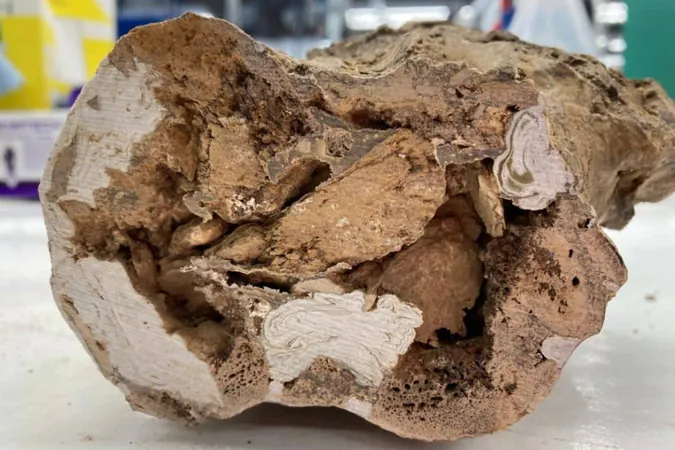
Shocking Discovery of 66-Million-Year-Old Collagen in Dinosaur Bones Could Rewrite Paleontological History!
2025-03-17
Author: Ken Lee
A Groundbreaking Find in Ancient Remains
The groundbreaking study centered around a remarkably well-preserved hip bone from an Edmontosaurus, a duck-billed dinosaur that roamed the Earth during the Cretaceous period. Weighing in at approximately 50 pounds (23 kilograms), this fossil was excavated from the famed Hell Creek Formation in South Dakota and now resides in the prestigious collections of the University of Liverpool.
Using cutting-edge mass spectrometry and advanced protein sequencing techniques, the scientists discovered remnants of collagen within the bone. Professor Steve Taylor, the research lead, stated: “This research shows beyond doubt that organic biomolecules, such as proteins like collagen, appear to be present in some fossils.” This newfound evidence suggests that under certain conditions, organics can endure far longer than previously thought, raising intriguing questions about the fossilization process.
Understanding the Importance of Collagen
Collagen is the predominant protein found in bones, integral to their structure, flexibility, and overall strength. This distinguishes it as a critical factor in understanding the integrity of both modern and extinct animals' bones. Normally, collagen undergoes decomposition over time, often turning into gelatin when exposed to heat and moisture. The fact that traces of this essential protein have been discovered in such ancient fossils is nothing less than extraordinary.
Confirming the Collagen Discovery
The research team employed sophisticated high-precision techniques to substantiate their findings. By leveraging protein sequencing and tandem mass spectrometry, they were able to identify and isolate specific molecular fragments of collagen while ensuring that contamination from modern substances was ruled out. Imaging techniques revealed intact bone structures, further supporting the presence of preserved organic remnants. Notably, the analysis highlighted collagen alpha-1 fragments, a fundamental component in bone structure.
Supporting evidence was also validated through collaborative efforts with the Center for Proteome Research at the University of Liverpool and UCLA, where further advanced mass spectrometry confirmed their remarkable discovery.
Professor Taylor elaborated, “These images may reveal intact patches of bone collagen, potentially offering a ready-made trove of fossil candidates for further protein analysis.” This opens a new chapter in paleontological studies with exciting potential.
The Quest for More Ancient Secrets
This remarkable capability to identify ancient proteins within fossils has opened expansive research avenues. It could inspire scientists to revisit museum collections, allowing for the possibility that previously dismissed fossils might still harbor traces of their original organic materials.
Moreover, archived cross-polarized light microscopy images may reveal even more samples containing intact patches of bone collagen. Researchers are now encouraged to reanalyze historical fossil collections using modern techniques, potentially unlocking a treasure trove of insights into dinosaur physiology and evolutionary history.
Conclusion: The Dawn of New Paleontological Discoveries
As scientists delve deeper into this extraordinary finding, the implications for our understanding of prehistoric life are immense. The unearthing of collagen in such ancient remains may not only change the narrative of fossil preservation but could redefine what we know about the biology of dinosaurs. Stay tuned as we continue to follow the fascinating developments in this revolutionary area of paleontology!



 Brasil (PT)
Brasil (PT)
 Canada (EN)
Canada (EN)
 Chile (ES)
Chile (ES)
 Česko (CS)
Česko (CS)
 대한민국 (KO)
대한민국 (KO)
 España (ES)
España (ES)
 France (FR)
France (FR)
 Hong Kong (EN)
Hong Kong (EN)
 Italia (IT)
Italia (IT)
 日本 (JA)
日本 (JA)
 Magyarország (HU)
Magyarország (HU)
 Norge (NO)
Norge (NO)
 Polska (PL)
Polska (PL)
 Schweiz (DE)
Schweiz (DE)
 Singapore (EN)
Singapore (EN)
 Sverige (SV)
Sverige (SV)
 Suomi (FI)
Suomi (FI)
 Türkiye (TR)
Türkiye (TR)
 الإمارات العربية المتحدة (AR)
الإمارات العربية المتحدة (AR)